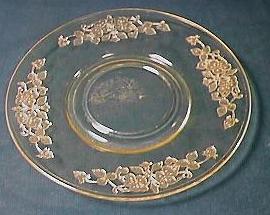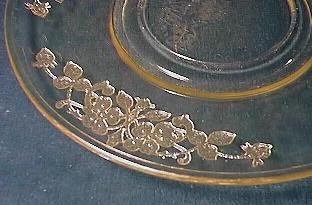

Collecting Vernon by Indiana Glass
Written by Rosemary Trietsch
True story. The setting: my kitchen, early evening, as my husband and I prepare dinner. The conversation:
“I’ve got to get my moving on my article for this month.”
“What
are you writing about?”
“Vernon.”
“Vernon?”
“Yeah,
it’s a pattern by Indiana Glass that just had a number so Weatherman named it
‘Vernon’ after her husband.”
“Good
thing she didn’t call him ‘snookums’.”
I
spent this past summer working on my research library, tracking down the early
volumes on Depression glass that Hazel Marie Weatherman wrote as well as the
Price Trends she put out afterward. It’s fascinating to follow the evolution
of information from 1969 to 1984 on the patterns we’re so familiar with. Every
year, Hazel added new pieces to the listings, corrected measurements on things
already listed, and issued warnings about reproductions that had entered the
market. Yet with all the new material that she uncovered, (and we continue to
uncover), the information on Indiana’s Number 616 has remained virtually
unchanged since 1969, when Hazel first named it “Vernon” in her “Guidebook
to Colored Glassware of the 1920’s and 1930’s.”
Indiana
Glass Company has been around in some form or another since the late 19th
century. Originally part of the Ohio Flint Glass Company and later sold to the
National Glass Company, Indiana finally incorporated in 1907 and has been in
operation ever since. Their first lines of tableware were molded by hand and
consisted of heavy, crystal glassware made with ‘tea rooms and soda
fountains’ in mind. Avocado (No. 601), Tea Room, Pyramid (No 610), and Old
English (Threading) appear in company records from 1923 to 1933 and were among
the first patterns Indiana made. Color was the next addition, with green and
amber beginning in 1925, pink in 1926 and topaz/yellow in 1930. Finally, in the
late 1920’s, when mechanization came to the glass factories, Indiana added
thinner, mold etched dinnerware lines to their repertoire. Lorain, Horseshoe
(No. 612) and Vernon (No. 616) all date to this production period – from 1929
to 1933 – and are the only three mold etched patterns Indiana ever produced.
For a brief time, the Indiana Glass Company was
successfully producing both machine made and hand pressed glass. Unfortunately
for us, the Depression seemed to hit the Indiana factory very hard, and by 1933
they had ceased production of all of the above patterns as well as pink, yellow,
and green colored glass. Today, all of them are in short supply, with No. 616
the most limited of the bunch. Manufactured from 1930 to 1932, No. 616 can be
found in crystal, yellow and green – if you’re lucky. There are only seven
different pieces available in the set: a cup and saucer, sugar and creamer, 8
inch luncheon plate, 11 ½ inch sandwich plate, and a footed tumbler. You can
make a lovely luncheon service or desert set, which was probably Indiana’s
intention when they marketed No.616. Collectors
who are lucky enough to find them, use the 11-½ inch sandwich server as a
dinner plate, thereby expanding the possibilities.
The trick with ‘Vernon’ is not figuring out how to use it, but finding it in the first place. There is so little of it around that it prompted Hazel to remark,
“Still this pattern is so scarce, it is practically invisible. Wouldn’t you like to know the story behind it – why Indiana saw fit to discontinue so exquisite a design after so short a time? I surely would.” (Price Trends, 1973)


In
1971, Sandra McPhee Stout says, “This was a tea company premium and may have
been a premium for other outlets as well. Only ten items have shown up to
date.” Now, much of the
Depression glass we have was used as premiums for one product or another,
and this may explain the relative scarcity of No. 616. Perhaps Indiana
produced a small amount of it to fill this tea company’s small order. Perhaps
they used No. 616 to fill the premium order because they had hadn’t made much
of it in the first place. We may never know.
What’s more intriguing, however, is the statement
that ‘ten pieces have shown up to date.’ In her original 1969 listing for
No. 616, Weatherman included a sherbet, a 3-part relish dish, and a 6-inch
plate, bringing the total number of items available to ten. This is probably
where Stout got her information. It may have been wishful thinking on Hazel’s
part as they’re are not pictured anywhere, but a sherbet, relish dish and
6-inch plate would certainly round out a luncheon service nicely. These pieces remained in the Price Trends lists until 1978
when they vanish without explanation. There is no mention of records that had
been found proving they had not been made, or why she was no longer including
them. They simply aren’t listed anymore. I think it’s reasonable to infer
that none ever turned up and the price listings were adjusted accordingly.
(Something I found interesting as I researched No. 616: In Carl Luckey’s 1994
“Depression Era Glassware,” he lists 15 pieces as available in No. 616. In
addition to the 7 known pieces, he adds 4 different size bowls, a pitcher, grill
plate and 2 other tumblers. Makes you wonder, doesn’t it?)
If you’re lucky enough to have a collection of
“Vernon”, you know that it has the sharp mold lines that are characteristic
of Indiana glass. (Besides the psychological pain you suffer finding it,
drinking from the cups and tumblers can inflict physical pain if you haven’t
carefully checked the inner rims where these mold lines lurk.) It’s such a
beautiful pattern, though, that you can overlook such ‘little annoyances’
and enjoy the way it brings life to your table. When I’m lucky enough to find
a piece of No. 616, I really feel like I’ve found a treasure. Perhaps Hazel
felt the same way about it and that’s why she named it for her treasure.
Sources: Hazel Marie Weatherman; A Guidebook to
Colored Glassware of the 1920’s and
1930’s; 1969
Price Trends, 1973, 1978, 1984
Sandra McPhee Stout; Depression Glass Number Two,
1971
Gene Florence; Collector’s Encyclopedia of
Depression Glass, 13th
Carl F. Luckey; Depression Era Glassware, 1994